Running It by Michael: A Tribute to Michael Armstrong
2November 24, 2016 by Tom McKenna

Editor’s note: We invite you to enjoy this short collage of memories of revered Bread Loaf professor Michael Armstrong. Please join the conversation via the comments section below, and share your reflections on Michael’s impact on your teaching and learning.
Education as Critical Practice
Michael Armstrong was a radical educator and teacher-researcher who held that a “pedagogy of the imagination” is “more rigorous, more exacting, and more intellectually demanding than any traditional ways of formal teaching.” Michael’s strategies were never romantic: he held that education is a critical practice. At Bread Loaf, Michael stated clearly, directly, and frequently his belief that a crucial issue for us who teach and study at Bread Loaf is reducing inequality.
In 1999 Michael held up for public scrutiny the concept of mandated educational standards. Such a concept is troubling, Michael wrote in 1999, because:
“….a standard is a measure… but the most dynamic characteristic of learning, which for want of a better term I will call its creative aspect, cannot be measured… Moreover, a standard is a measure of conformity whereas education is as much, if not more, concerned with non-conformity: with exception rather than rule; with the novel, the unexpected, the re-described and re-constructed; with the revival of learning no less than its transmission, and with innovation as well as tradition. In short, education is a critical practice.”-Dixie Goswami
Mountains Can Swim
I like to run things by Michael, and that’s definitely why I have this drawing on my classroom wall. It’s a work of art that my two-year old son Elliot drew. 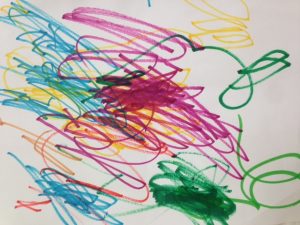 The drawing hangs alongside the self-portraits my children (my students) drew on the first day of school. I ran the self-portrait idea by Michael first, and I heard laughter turn into applause as it normally did when Michael ended his classes; I heard Michael say, “See you tomorrow,” then I heard the Barn door clap and the gravel on the drive rumble and crunch, and it brought me back to new possibility. “I want to see how you see yourselves, and I want you all to know on the first day of school that you are artists, readers, teachers, writers, creative thinkers, and you have a home here in our classroom.”
The drawing hangs alongside the self-portraits my children (my students) drew on the first day of school. I ran the self-portrait idea by Michael first, and I heard laughter turn into applause as it normally did when Michael ended his classes; I heard Michael say, “See you tomorrow,” then I heard the Barn door clap and the gravel on the drive rumble and crunch, and it brought me back to new possibility. “I want to see how you see yourselves, and I want you all to know on the first day of school that you are artists, readers, teachers, writers, creative thinkers, and you have a home here in our classroom.”
“Mr. Peters, who drew that? Whose self-portrait is that?”
“That’s Elliot’s self-portrait.”
“Why’d you put it up next to ours?”
I ran it by Michael, and he reminded me that you are still that child who wants to create with markers, clay, crayons, and paint. You are still that child who runs to hear and tell stories. You all have the questions inside of you that must be asked, like the one Elliot asked me recently: Can mountains swim? I ran my answer by Michael first.
Mountains can swim, ducks can wear pirate hats, and you can smell clouds.
I run things by Michael, and I discover that Michael’s care and attention are still at home in me—pointing me towards the direction of wonder—where mountains swim—and I keep hearing laughter turn into applause and keep seeing him tomorrow.
-Brent Peters
A Radical Act
I was never lucky enough to be in a class that Michael taught, but the first time I witnessed his talk about “The Poorly Mouse” changed me forever. I was at Bread Loaf with the ABL teachers visiting the campus. What struck me in Michael’s analysis was how rich, sophisticated, and nuanced this child’s — and every child’s — imagination was if their work was analyzed the way we would analyze the work of an adult or accomplished artist. My epiphany that day was reinforced over the years by the weeks Michael spent working in Lawrence with teachers, students, artists and the Addison Gallery in projects Mary Guerrero and other Lawrence teachers did with their students. A culminating event for me was when Lusanda and Ceci brought their students from Johannesburg and Tombstone, AZ, respectively, to work for a week with Mary’s students and Michael in Lawrence on the Language Acquisition Project. The teachers and students were involved in a two year long exchange, and thanks to the Spencer Foundation, had the opportuntiy to meet and work face-to-face on the project. Seeing and hearing these youth, and especialy Mary’s third graders who were seen as the real experts on language acquistion, was another life-changing experience for me. Michael taught me about the sacredness of the human imagination and of its potential to transform individuals and a society. He taught me that educating the imagination is a radical act, one that enables youth and adults to recreate their world and the world of the communities in which they live.
-Lou Bernieri
New Avenues for Understanding
The consummate teacher, Michael Armstrong never stopped teaching me how to look at the world and my place in it. My senior year at Bread Loaf, I enrolled in a course that was to be co-instructed with Michael and Suzanne Wofford. The course, “Narratives of Origin and Origins of Narrative” planted a seed that has continued to grow. In the summer of 2000, I had the privilege of participating in a Spencer Foundation conference that was hosted on the Bread Loaf campus in Vermont. During this session, I learned from Michael that we all have stories and that our stories provide us with ways to connect ourselves to the world in which we live.
Inspired by his unending inquisitiveness, I learned how to apply this curiosity to my own teaching practice and my personal life. Having been awarded a Spencer Foundation Research Grant, Michael, I, along with Mary Guerrero, and Lusanda Mayikana, worked with students to understand what it means to acquire a second, or as in the case of the South African students a third or fourth, language. During this three year research project, Michael taught me how to question everything and to look closely at what I was reading, hearing, and seeing, particularly as these observations related to students.
During our research project, Mary, Lusanda, and Mary traveled to Arizona to meet with my students and to experience life in the borderlands. I will always remember his child-like interest in the numerous dirt roads that seem to head nowhere in Cochise County. Visiting with my students, Michael posed this question to them: “Why do the roads just seem to stop here?” Cody, a senior at Tombstone High School, raised his hand and jumped up from his seat to answer Michael’s question.
“Well, that’s where the horse died.” The class erupted in laughter. Michael, on the other hand, could be seen writing down Cody’s remark with interest and recognition. After reflection, I realized that Michael never dismissed anything. In his curious way, he illustrated how everything, every comment, provides us with an avenue for understanding. I do not travel on a dirt road today without wondering about its origins and the horse that might have died on it.
-Ceci Lewis
Honoring the Imagination
In 2013, as I sat in a circle and discussed work of a student in Michael’s “Describing the Imagination” class, I was asked not to grade the work, but to understand the work and the student who produced the work. What is a student telling us about herself when she stitches black and red patches over a white cloth doll when asked to make a monster for her Fantasy Literature class? Is there a story, a personal one underneath? Does this represent, symbolically, the patchwork of what scares her about being alive, human, and awake? Does this student know about Frankenstein and his monster?
Michael taught us how to honor the imagination and through it the process of experimentation, reflection, and growth. Words like standards and rigor are not at ease in these conversations. Instead, words like possibility and play are the hallmarks of his, of a pedagogy based in the imagination.
Michael taught that an imaginatively reflective practice is a responsive practice. Out of necessity, a practice focused on reflection engages with the student where she is in her individual learning process. It meets her and contributes to her learning in a way that best fits her needs. It reduces fear of learning, fear of being different. It celebrates our diverse ways of being in the world and imagining our world.
Through Michael Armstrong’s courses, hundreds of Bread Loaf students learned how to be more imaginative teachers. Through those teachers, students across the world benefit from the limitlessness possibility of an imaginative pedagogy.
-Chris McCurry
A Gold Standard of Pedagogy
Every good teacher has a signature style. Excellent teachers habitually do so many good things in the course of their teaching, any number of which can pass off as a signature style. It has been some time since I took Describing the Imagination, and Calvino, two courses taught by Michael Armstrong at Middlebury Bread Loaf School of English. Despite this passage of time, these classes remain memorable. Michael’s chasses were characterized by respectful deliberations, deep and free conversations, inclusive circle sitting formations, extended classroom conversations through a number of out-of-class interactional avenues, and creative multimodal compositions as culminating course assignments. They were also characterized by class journals (in the form of a physical binder). I remember how he encouraged, nurtured, and challenged us to extend our thinking and application through the incisive comments that he made on all pieces we had submitted in the class journal. Over the Bread Loaf summer, the journal would “grow” filling up with student-submitted content and peer feedback such that a second folder would be procured. One thing (among many) that struck me was how he meticulously read every paper in these journals, commented on each of these and remembered specific content when discussing with class members. These bulging class journals are one impression among legions that characterize his signature teaching style. Years after taking these courses taught by him, I strive to emulate his unending dedication when reading and responding to electronic submissions by my own students. What a great honor to learn from him, to see teaching come alive in such impassioned ways, and to have a gold standard of pedagogy set so high!
-David Wandera
Attending to Meaning
It wasn’t long after I arrived on the Bread Loaf campus for the first time–a matter of days after feeling that “What have I gotten myself into?” wave of nausea–that I sat in a circle on the Bread Loaf lawn with Michael Armstrong in the 1991 Bread Loaf class Reading and Writing the Imagination. Michael wore yellow pants, and as I recall, a yellow sweater. He reminded me of a bumblebee with his quick flights of intellect and his assiduous attention to each of our ideas. Whether responding to a turn of a phrase with “That’s fascinating!” or debunking some prevailing curricular trend wth “Preposterous!,” he buzzed with interest in our intellectual development. What transpired over the next few weeks would change everything I knew about teaching and about the whole purpose of education. This class was the most democratic teaching and learning experience I had had since kindergarten. We presented together, we composed a “class book” / journal together. We drew, we acted, we read, we imagined, we interpreted, we described, and we wrote. It was hard work and hard play. For the rest of my classroom career, my clumsy paraphrase of Michael’s eloquent reminders of the teacher’s role of interpreter became a calling to my better self. “We need to bring every scrap of our adult literary knowledge to our children’s work.” Through my final conversations with him, Michael reminded me of the primacy of attending to children’s meaning as opposed to the prevailing obsession over form. He still reminds me that my most important work is in helping to create learning environments in which young people can collaboratively create meaning and culture using all of the resources available to them.
Below is a short excerpt of Michael’s writing in response to Robert Baroz near the conclusion of the 1990 course, Recreating the World through Narrative. Note Micheal’s reflections on the the “authority of the text” and power of this public genre, a venue for each classmate to use written reflections to make meaning together.
-Tom McKenna
Please share your memories and reflections on Michael’s impacts below.
Category Faculty Notes, Fall 2016, Featured | Tags:
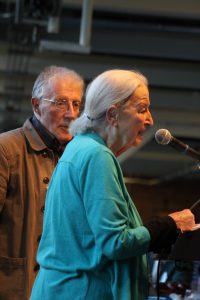
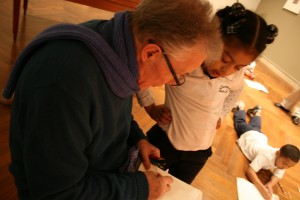
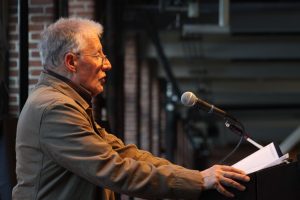
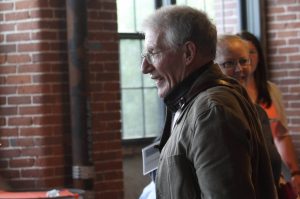
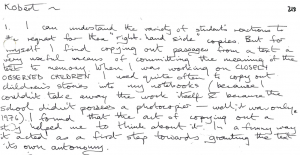
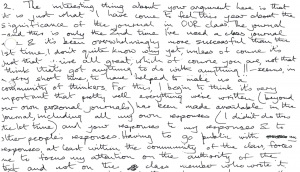
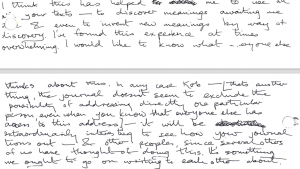
My fondest memory of Michael is him zooming around on a motorized cart with a large inflatable rubber duck and a squealing crouton or two, hanging on for dear life. No man loved children more. He graciously allowed me to audit his courses, and he responded with such careful, loving detail to my writing that I passed that gift on to my own students. Dear Michael, touch Rocky Gooch, Tim Miller, and Jimmy Britton for me.
My fondest memory of Michael is him zooming around on a motorized cart with a large inflatable rubber duck and a squealing crouton or two, hanging on for dear life. No man loved children more. He graciously allowed me to audit his courses, and he responded with such careful, loving detail to my writing that I passed that gift on to my own students. Dear Michael, touch Rocky Gooch, Tim Miller, and Jimmy Britton for me.